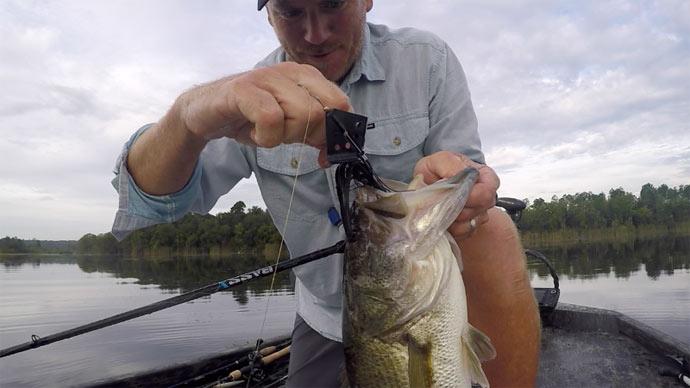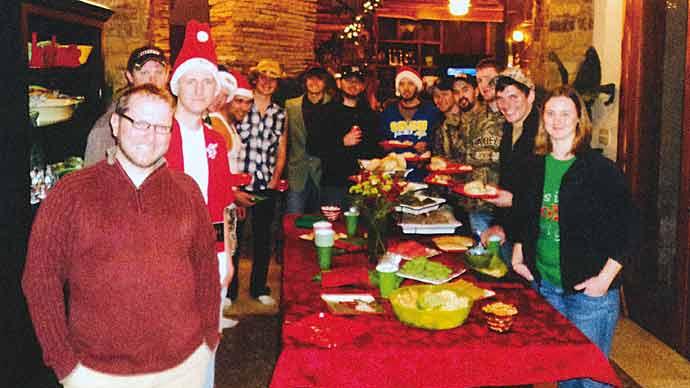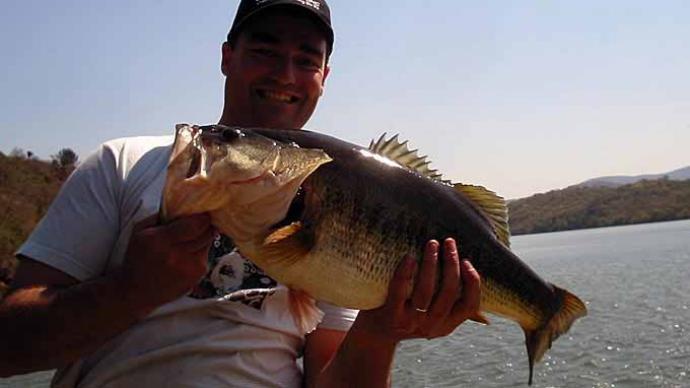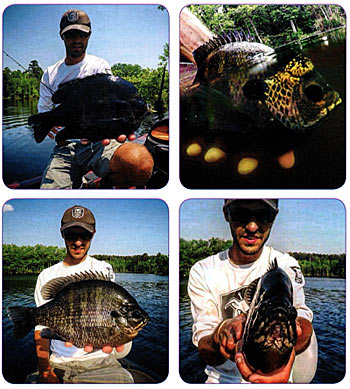
I was pacing. When I spend time in airports, I usually try to walk as much as possible because I will be sitting on the flights. On this particular day, however, I was pacing more out of anticipation than anything else. I was heading to King Fisher Society, home of the legendary bluegill fishery of Richmond Mill Lake. I had been dreaming of this day for literally the past four years of my life.
There was a time in my life when bass was all I fished for. I remember scoffing at the guys who would spend all their time fishing with light line and tiny jigs for what I would call "baitfish." The new me doesn't like that part of the old me. I vividly recall the first time I put down my bass rod solely to fish for bluegill. I was taking a quick break from bass to fish for crappie, and as I pulled my crappie jig past some deep timber, I felt the sharp tick of a bite. My father and I were in our tiny 8-foot pond boat, and I remember feeling nervous as the fish on the line began to turn our boat and eventually pull our little vessel out to deep water. "Get the net, Dad, serious bass," I remember being in awe as that bluegill finally surfaced. Looking at it spread across both hands, I realized my newest obsession in that instant.
A huge fish of any freshwater species has different characteristics than a typical specimen. The way they look, their bigger scales, their eyes, and their shape are different. I have seen these countless times with bass, but looking at this 11-inch bluegill, I realized it also held true for this fish. The giant forehead, thick back, bigger eyes, the deep belly. Ever since that fish, my respect for these fierce, colorful panfish has grown with each tick I feel at the end of my ultralight rod. And now, somehow, I was getting on a plane to head to Laurel Hill, North Carolina, to what is arguably the best bluegill fishery on the planet.
The pacing continued.
What seemed like an eternity to an impatient fisherman (which was a quick couple flights and a short layover), I wound up at King Fisher Society around 10:00 PM. I was shown to the lodge and offered some refreshments. I had a quick thought about the amenities and how great they seemed, the sheer awesomeness of the history, the over-the-top bed, and all the accommodations, which I could go on about for hours, but honestly, all I could think about was getting on the water the following day. I looked over the gear offered and was delighted to find they had the perfect ultralight setups for what I had in mind. I organized and tried to sleep. 5:00 could not come fast enough.
I found myself on the dock at around 4:45, set myself up on a boat, and likely had a line in the water earlier than anyone ever has at that lake. Most clients at this body of water are outfitted with a guide, but for my trip, I spent most of my time exploring this pristine lake solo. I made my first cast as sunlight barely crept over the horizon.
My first few hours of fishing were a struggle. I had difficulty putting a pattern together quickly and covered a lot of water in hopes of lucking into some bedding fish.
Seeing as I could not find any beds, I found a steep bank and worked my way down it, slowly pulling my 1/32-oz jig with a 3-inch plastic hellgrammite down the bank. Eventually, my line jumped, and I felt the rod jolt. This wasn't a simple peck like 7-8-inch bluegill makes. This was a jolt. I lifted my rod, and immediately the big bull bolted for deeper water. I have rarely felt outgunned while bluegill fishing, but this one made my 4-lb line scream off the reel. Eventually, I worked the fish to the boat and netted my first King Fisher gill. 10.5 inches of fury. No time for pictures. I have started a pattern.
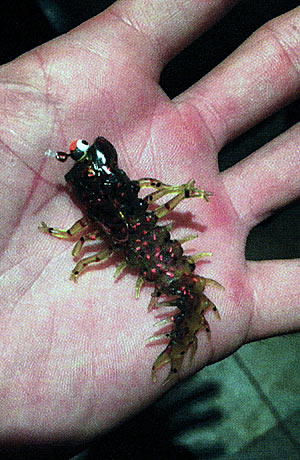
I continued down this bank every 10 minutes or so, feeling a jolt and squealing with excitement when the fish would tear off to deeper water and shortly tamed. Eventually, this steep bank opened up to a small shoreline flat, and I could finally see what I could not see earlier in the wee morning light: a small group of big, round craters nestled neatly next to an overhanging tree. I got as close as I dared and skipped my bait under a tree. The biggest bluegill of the bunch SHOT off his bed and smacked the lure before I could flip my bail. 11-inches of pure coppernose bluegill. I was a happy camper.
By mid-afternoon, I was having a blast. I was happy to hear that Dave Buhler, KFS's property manager, was coming out to join me. I had found a fair amount of beds and had caught some truly serious bluegill, but I knew how big the bluegill in this body of water got, and I knew I had not come close to that mark yet. Dave's insights led us to a big overhang tree near some spawning grounds. Dave was reeling in bass right and left, and I was working around the tree tirelessly with my small jig. Right next to the shore, I made a longer cast, worked the jig off the 2-foot-deep spawning grounds into about 4 feet of water, and saw my line jump. I lifted the rod into a hefty fish. The interesting thing about these bigger bluegills is that their fight is nothing like regular bluegill. There aren't many circles. Most bluegill fight in a tight, clockwise circle as they try to escape. For these huge ones, it's more a steady, long run straight to deep water, and this fish was heading there. I told Dave to get the net, but he was already beside me. He knew the fight of a big bluegill.
When we got the fish in the net, I was beside myself. I've been fortunate enough to catch giant peacock bass, monster tarpon, and some big payara, but this fish meant just as much to me as any of those. 12-plus-inches of bluegill, easily 2-pounds, was squirming in my hands. THAT is why I came to King Fisher Society.
The next day, I was on the water at about the same time, and this time around, I knew a ton more about the water and the fish. I headed to the spawning grounds but stayed a good way off them and cast a tiny grasshopper popper to the cover next to the beds. A loud pop broke the peaceful, calm morning, and the popper disappeared. Another solid 11-incher to start the morning.
If it isn't obvious, I could go on for days about each fish I hooked on the trip. But what I did find interesting was that tactics that I used to catch big bluegill in the past didn't work that well here. I was planning on using a 1/50-oz jighead and a 1-inch craw most of the time. I certainly did catch fish on this bait, but I had far more and far bigger bites on a 1/32-oz jighead and a 3-inch plastic hellgrammite in green pumpkin. The fact that this bigger bait was getting eaten so well did surprise me. I have always subscribed to the school of using tiny baits for big bluegill, but from now on, when I am targeting very serious bluegill, I will not hesitate to throw a bigger bait. I was concerned that this long bait would not fit in the fish's mouth and would not offer a good hookset. However, nearly every fish had the bait so far down that I could close their mouths and not see it. I learned that the soft plastic of the bait would fold up easily inside the big bluegill's mouth, ensuring a perfect hookset nearly every time.
The popper was arguably the most fun bait to throw, but when that bite would die as the sun rose, the bigger jig was the ticket. The 1/32-oz jighead, which I consider heavy for bluegill fishing, allowed me to cast far enough to stay away from my quarry, yet all of the appendages on the lure gave it a slow enough fall to still entice the bluegill.
Although the spawning beds produced fish, I was able to catch fish consistently around the spawning grounds. Clearly, the bluegill were not fully on beds, as many were just in the deeper water adjacent to the spawning grounds. I recall casting to the empty beds and pulling it off the flat, only to get crushed once the lure started sinking into the deeper water. Since I usually am shorebound, I also overlooked a few deeper flats on the outer edges of the lake's coves. There were beds in about 3-4 feet of water. Although the fish were not on them, I could capitalize by fan casting around these beds to any bluegill staging near them, waiting for the water temperature to warm up a few more degrees before they committed to a bed.
I had the time of my life at KFS. I learned a lot about targeting these fish, and I caught the biggest bluegill of my life, time and time again.
This body of water is by no means like shooting fish in a barrel. It took me some time and effort to pattern these fish, and each big bluegill I caught took a little bit of luck and a fair amount of angling skill. That being said, if you ever find yourself restlessly pacing in an airport, about to board a plane to North Carolina, rest assured: your angling skills will be put to the test by these incredible fish, and if you put the effort in, there is a darn good shot that you will come face to face with the biggest bluegill of your life.
Reprinted with permission from Pond Boss Magazine

